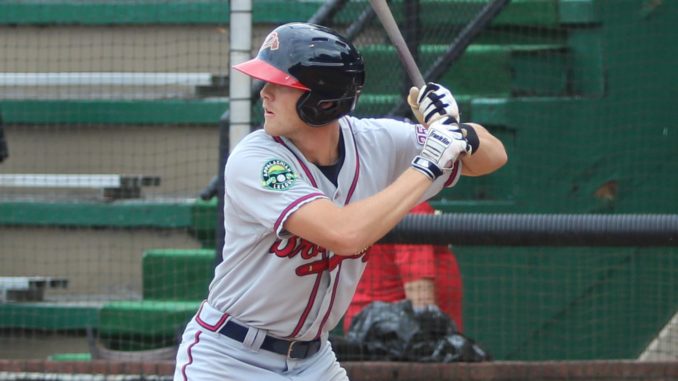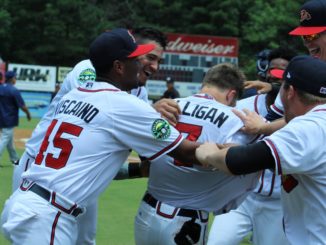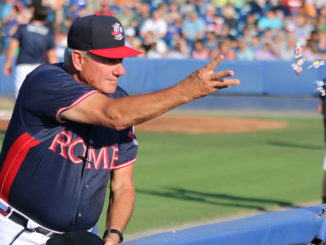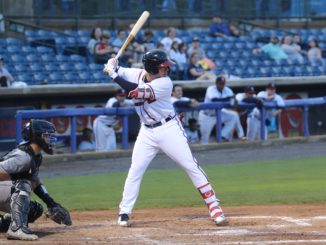
The Danville Braves this season was stocked with collegiate draft picks and international talent that had matriculated up through the complex leagues. The team was an Appalachian League powerhouse for the first two months of the season but faded badly in August as the drain of talent to populate the Rome roster and injuries became too much and the Wander Franco-lead Princeton Rays broke away from the pack.
At an average age of 21.3, Danville was nearly a full year older than the average Appy League team, reflecting it’s predominantly collegiate make-up. If the core of this team makes up the core of next year’s Rome Braves team, Rome should have a good 2019 despite a dearth of marquee prospects.
Here are the players that stood out this season.
Infield
First base was almost evenly split between Nicholas Vizcaino, an undrafted minor league amateur free agent signing in 2017, and Griffin Benson, a 23rd-round pick in 2016. Benson was the stronger performer, hitting .269/.345/.433 with 3 home runs.
Second base belonged to reigning NCAA Division I batting champion Greg Cullen out of Niagara University. Cullen took about 10 days to get acclimated to pro ball and wooden bats, then took off after a two-hit night in Greeneville. Starting that night, Cullen hit .299/.383/.431 the rest of the way with 3 homers and 10 doubles.
Shortstop was initially manned by 9th-rounder AJ Graffanino, but after hitting .407 over 10 games, he was sent to Rome to take the place of the promoted Riley Delgado. Two Danville veterans, Nicholas Shumpert and Luis Mejia, shared the position the rest of the way. Shumpert demonstrated an improved glove at short and hit a respectable .248/.302/.401 with 2 homers and 12 doubles, with most of that production coming later in the season as he stayed in the line-up more consistently.
CJ Alexander was not part of the Opening Day Danville roster, but after destroying GCL pitching over 9 days he was moved up, where he proceeded to destroy Appy League pitching to the tune of .354/.439/.488 before the Braves promoted him to Florida to look for a league that could get him out. Brett Langhorne, who also logged time at first and short, was the primary third baseman before and after Alexander’s tenure and hit .281/.375/.341 and looks to be a good super utility option.
Outfield
The season began with a primary outfield of draft picks Greyson Jenista, Andrew Moritz, and Justin Dean. After Jenista hit 3 home runs in 10 games, he was quickly moved up to Rome, essentially swapping places with 2017 20th-rounder Justin Smith. Smith ended up easily leading the team in homers with 7 while hitting .246/.341/.475, but also with 44 strikeouts in 135 plate appearances (32.6%).
Dean proved to be the most productive D-Brave after Alexander, hitting .308/.419/.454 and playing an impressive centerfield. He was an easy selection for the Braves to move up to Rome to replace the promoted Drew Waters for the last month of the season.
Andrew Moritz, who finished third behind Cullen in NCAA DI batting average this season, was batting .325/.379/.455 by mid-July, but started to slump as the summer wore on. He finished the season at a still-respectable .280/.352/.376 before shutting it down at the end of July with an injury.
Carlos Baerga ended up logging the most total games in the outfield and showing strong defensive skills and a strong arm. Twenty-four year-old Cuban Henry Quintero played primarily right field and batted a pedestrian .262/.282/.363, though he was bothered by injuries on-and-off all season.
Catcher
Danville had four catchers vying for playing time behind the dish, each with their own strengths and weaknesses.
Twenty year-old Ricardo Rodriguez was the youngest position player on the team and shows solid receiving skills that still need polishing and the beginnings of some power in his bat, though overall he only hit .228/.308/.331.
Ray Soderman was the most polished catch-and-throw receiver and has the makings of a solid organizational catcher, but has almost no feel for hitting.
The rest of the innings were filled by 24th-rounder Rusber Estrada and Zack Soria, the “old man” of the squad at 24 years old. Estrada is a raw talent with a strong arm while Soria is more likely an organizational player.

Starting Pitching
Danville got solid starting pitching most of the season from right-handers Jose Montilla and Matt Rowland and lefties Dilmer Mejia and Tanner Lawson.
Montilla had a sterling 2.45 ERA at mid-season, but seemed to fade down the stretch as the 20-year-old easily blew past his career high in innings, ending the campaign with a 4.37 ERA.
Rowland is a Pope High School alum out of Cobb County and 11th-round pick back in 2016 who made his major league debut in his first start of the season, coming back from a torn UCL suffered immediately after signing. The Braves carefully monitored Rowland’s pitch counts and innings as you would expect, but in between rustiness and some lack of command, Rowland showed a live fastball and a potential plus curveball.
Mejia was named the Appalachian League Pitcher of the Year after pitching to a 2.87 ERA in 69 nice innings. Mejia has been pitching as a pro for the Braves since he was 16, but is now finding a groove as a control and command left-hander.
Lawson was a 21st-rounder and was kept on an even tighter leash than Rowland after his collegiate season, maxing out with a 62-pitch start. Nevertheless, Lawson showcased good control and a potential plus curveball.
Matt Hartman was signed as an undrafted free agent out of Westmont College in California at mid-season and proved to be a steadying element, pitching to a 2.87 ERA in 5 starts.
Relief Pitching
Danville had a solid bullpen filled with older collegiate pitchers, some of which could be contenders for spots in minor league rotations next season.
The highest upside arm belongs to 2018 5th-rounder Trey Riley, who only appeared in 6 games (2 starts) who flashed strike-out stuff and questionable control. despite the mixed results, look for Riley to get every opportunity to snag a Rome rotation spot next season.
Other 2019 starter candidates include lefty Jake Higginbotham and Mitch Stallings and righties Ryan Shetter and Nolan Kingham. All four have big-college experience, and all four had their opportunities limited to keep their innings down. Higgenbotham had the best results of the group.
Other 2019 draftees with strong debuts include Brooks Wilson and the three Zachs: Zach Seipel, Zach Daniels, and Zach Guth. Daniels and Wilson have already moved up to Rome.
TOP 10 2018 DANVILLE BRAVES PROSPECTS:
1. Trey Riley, RHP
2. Nolan Kingham, RHP
3. Jake Higgenbotham, LHP
4. Andrew Moritz, OF
5. Greg Cullen, 2B
6. Matt Rowland, RHP
7. Dilmer Mejia, LHP
8. Nicholas Shumpert, SS
9. Ricardo Rodriguez, C
10. Jose Montilla, RHP




Leave a Reply